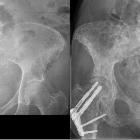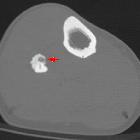osteopoikilosis
Osteopoikilosis is a sclerosing bony dysplasia characterized by multiple benign enostoses. It is a rare inherited benign condition incidentally found on skeletal x-rays. Its importance is predominantly in correct diagnosis so that it is not mistaken for pathology.
Epidemiology
The bone islands of osteopoikilosis develop during childhood and do not regress and therefore are seen in all age groups. There is no gender predilection.
Osteopoikilosis is inherited as an autosomal dominant disorder .
Clinical presentation
The condition is asymptomatic and does not degenerate into malignancy. Bone strength is normal.
Pathology
Histologically, the bone islands found in osteopoikilosis and in sporadic enostoses are merely patches of dense cortical-like bone complete with haversian canals located within the spongiosa, often just deep to the cortex .
A closely related entity is Buschke-Ollendorff syndrome.
Osteopoikilosis is often found concurrently with osteopathia striata, and melorheostosis, and it is thought by some that they represent a spectrum of the same condition termed mixed sclerosing bone dysplasia. Indeed recent genetic evidence suggests that these conditions are related to a loss of function mutation of the LEMD3 gene .
Other associations
- Gunal-Seber-Basaran syndrome: osteopoikilosis with dacryocystitis
- mixed sclerosing bone dysplasia: concurrent osteopoikilosis, osteopathia striata and melorheostosis .
- scleroderma
- tendency to keloid formation
Radiographic features
Plain radiograph and CT
The bone islands of osteopoikilosis are typically clustered around joints and align themselves parallel to surrounding trabeculae. Thus they are predominantly longitudinal in the areas of well-defined linear trabeculae, while more-or-less spherical where the trabeculations are not as well organized linearly. An example of the former is any of the five major groups of trabeculae seen in the femoral head and neck .
Most lesions are found in the appendicular skeleton and pelvis. The axial skeleton is largely spared. It is rare for the skull vault to be involved .
The lesions vary in size, usually 5-10 mm, but ranging from only 1-2 mm up to 1-2 cm.
MRI
Appearances on MRI are the same as individual bone islands. Each lesion is small and dark on both T1- and T2-weighted images, as it is composed of mature dense bone .
Bone scintigraphy
A bone scan should not demonstrate any increase in uptake, useful if metastatic disease is considered in the differential.
Osteopoikilosis is one of the skeletal “don’t touch” lesions.
History and etymology
The word osteopoikilosis derives from the Ancient Greek words ποικίλος (poikilos) meaning dappled or spotted and οστεον (osteo) meaning bone .
Differential diagnosis
When seen throughout multiple bones with characteristic appearances, there is little differential. When only a few lesions are seen on an isolated film, the differential includes:
- incidental bone islands (enostoses)
- other sclerosing bone dysplasias
- sclerotic metastases (rarely involve epiphyses)
- osteosarcoma
- lymphoma
- osteoid osteoma: only rarely multiple
- chronic multifocal sclerosing osteomyelitis
- calcium and phosphate metabolism abnormalities
- Erdheim-Chester disease
- previous instrumentation/fractures/avascular necrosis
- Paget disease
Siehe auch:
- Kompaktainsel
- osteoblastische Knochenmetastasen
- Aseptische Knochennekrose
- Osteom
- Osteoid-Osteom
- Morbus Paget des Knochens
- Osteosarkom
- Knochenmetastasen Mammakarzinom
- Dysplasia epiphysealis hemimelica
- Erdheim-Chester-Erkrankung
- Knochenmetastase Prostatakarzinom
- Knochenmetastasen Magenkarzinom
- Melorheostose
- Mastozytose
- Osteopathia striata
- Buschke-Ollendorff syndrome
- sklerosierende Knochendysplasien
- diffuse skelettale Sklerosierung
- Günal-Seber-Başaran-Syndrom
- multiple juxta-articular sclerotic foci
und weiter:
 Assoziationen und Differentialdiagnosen zu Osteopoikilose:
Assoziationen und Differentialdiagnosen zu Osteopoikilose:
























































